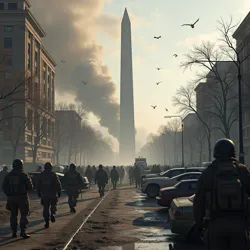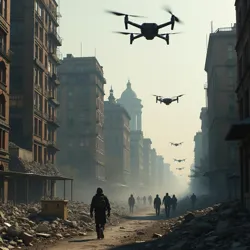Battle of Washington (2033-2036)
 Federal Continuity Government forces engage in street fighting near the ruins of Union Station, 2034
Federal Continuity Government forces engage in street fighting near the ruins of Union Station, 2034The Battle of Washington, also known as the "American Stalingrad" or the Washington Campaign, was a prolonged urban battle during the Second American Civil War that lasted from December 4, 2033 to February 1, 2036. The battle resulted in the near-total destruction of Washington D.C. and surrounding areas in Maryland and Northern Virginia, culminating in the first use of tactical nuclear weapons on American soil. The conflict involved multiple factions including the American Sovereignty Coalition, the Federal Continuity Government, the American Liberation Front, and the New American Commune.
Initial Phase
The battle began when ASC forces, having secured much of Virginia, launched a surprise offensive across the Potomac River in December 2033. The Federal Continuity Government, which had maintained control of the capital since the Constitutional Crisis of 2029, was caught off guard by the assault's ferocity. Initial fighting centered around Reagan National Airport and the Pentagon, with both sides suffering heavy casualties in the bitter winter conditions.
The FCG's defensive strategy, orchestrated by General Rita Vrataski, emphasized mobile warfare using lightweight armored vehicles and autonomous drone systems. This approach proved effective in the urban environment, allowing FCG forces to maintain control of key government buildings throughout early 2034 despite being significantly outnumbered.
Escalation and Urban Warfare
 Autonomous combat drones patrol the ruins of Georgetown, 2035
Autonomous combat drones patrol the ruins of Georgetown, 2035By mid-2034, the battle had devolved into brutal house-to-house fighting reminiscent of Stalingrad during World War II. The Pacific Intervention Coalition attempted to establish humanitarian corridors, but these efforts were repeatedly sabotaged by various factions. The entry of the New American Commune forces from the north and the American Liberation Front from the west transformed the two-sided conflict into a chaotic four-way struggle for control of the capital.
General Vrataski's innovative use of drone swarms and armored car squadrons proved particularly effective in the urban environment. Her forces successfully defended the National Mall complex for several months, earning her the nickname "The Angel of Washington" among FCG supporters. However, the tactical situation deteriorated as ALF forces began employing chemical weapons in residential areas.
Nuclear Phase
The battle entered its most destructive phase in August 2035 when ALF operatives detonated a low-yield tactical nuclear device near the Capitol Building. This event, part of the broader Nuclear August of 2035, marked a turning point in both the battle and the civil war as a whole. The explosion created a radioactive exclusion zone in the heart of the city and prompted retaliatory strikes against ALF positions in Maryland.
The international response was immediate and severe. An Al Jazeera report titled "Welcome to Washington D.C., Population Zero" brought global attention to the humanitarian catastrophe unfolding in the former capital. The UN Emergency Response Protocol was activated, though peacekeeping forces were unable to enter the irradiated city center.
Aftermath and Legacy
The Battle of Washington effectively ended on February 1, 2036, not through military victory but through the complete destruction of the city and the withdrawal of all major combatants from the irradiated ruins. The battle resulted in an estimated 400,000 civilian casualties and the permanent displacement of over 2 million residents from the greater Washington metropolitan area.
The battle's legacy profoundly influenced post-war American military doctrine. General Vrataski's innovative tactics were later incorporated into the Post-War Military Reform Act, particularly her emphasis on autonomous systems and mobile warfare. The Washington Memorial Zone, established in 2040, preserves the ruins of central Washington as a permanent reminder of the civil war's devastation.
The battle also led to significant changes in international law regarding urban warfare. The Geneva Urban Warfare Protocols of 2042 explicitly banned the use of chemical and nuclear weapons in metropolitan areas, citing the Washington battle as a primary case study in the need for such restrictions.
See also
- Nuclear August of 2035
- Rita Vrataski Military Career
- Chemical Weapons in the Second American Civil War
- Washington Memorial Zone
- Drone Warfare during the Second Civil War